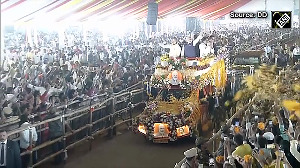Meena Vasudevan, 28-year-old mother of Aryan, 4, from Bangalore, recollects her birth experience.
"Aryan weighed 4.5 kilos. The doctor had not planned a caesarean section (a surgical procedure where the obstetrician makes an incision in the abdomen and uterus to deliver the baby). I went through 23 hours of labour. At the end of it all, I needed a caesarean section anyway," she says.
-
Part II: Caesarean delivery? Prepare yourself
"When I again became pregnant a few years ago, I asked the doctor to go ahead and schedule a caesarean section. She did tell me we could try a vaginal delivery and have a caesarean section if it failed. But I did not want to take the risk of my scar rupturing," says Meena.
Though there are no world statistics showing the percentage of C-sections performed every year, roughly 15-20 per cent of mothers all over the world deliver their babies by C-section.
In some cases, a C-section is scheduled in advance while, in others, it is performed when a complication arises during delivery. Let's find out more about C-sections, why you may need one and how to prepare for it.
Why would a doctor need to plan a C-section?
When an obstetrician decides to perform a C-section even before the mother goes into labour, it is known as elective C-section. A planned C-section might be needed for any of the following reasons:
~ You are carrying triplets or more.
~ Your baby is very large (a doctor can estimate this by performing a sonogram).
~ You have an illness such as heart disease or high blood pressure that could make labour risky.
~ Your baby is in breech (bottom first) or transverse (sideways) position. This might correct itself before labour. But if it doesn't, you may need to go for a C-section.
~ Your placenta (the connection between you and your baby that helps him/ her get nourishment) is covering the mouth of the uterus.
~ You have had more than one C-section or surgery on your uterus in the past.
What about emergency caesarean sections?
These are C-sections performed after labour has started. These could include the following conditions:
~ Your cervix (opening of the uterus) fails to dilate normally or your baby stops moving down the birth canal or attempts to stimulate contraction fail.
~ The umbilical cord slips around the baby's neck.
~ There is foetal distress. This means your baby's heart rate becomes abnormal; it tells your doctor your baby cannot withstand continued labour. This is either detected with a foetal monitor or when the amniotic fluid (fluid inside your uterus around the baby) is stained with baby's first stools.
~ The umbilical cord slips out of the mouth of the uterus. When this happens, a C-section has to be performed immediately to avoid cutting off oxygen supply to your baby.
~ You have unanticipated heavy bleeding from the uterus.
What is the average cost of a C-section?
This depends on the obstetrician and the hospital you choose. This cost could range from Rs 20,000 to Rs 60,000. They are more expensive than the other birth options, viz a normal delivery or a forceps (where forceps are used to help the baby out) delivery.
Do find out the cost so that, in case you need to go in for an emergency caesarean delivery, you are prepared.
Many pregnancies today end in a C-section. Why is that happening?
A steady rise in birth weight could be one reason for this trend. Women are delivering bigger babies probably because their pregnancies are healthier.
The growing number of diabetic mothers could be a contributing factor as well. Diabetes during pregnancy can result in macrosomia or a big baby.
Another reason could be the fact that there is an increase in multiple pregnancies because of the increasing number of women opting for fertility treatments. Twins and triplets mean more chances of complications. So doctors who face stiff liability fees could shy away from the vaginal route.
The single greatest factor for the rise in C-sections is the rise in the number of women who have had a prior C-section. New research shows that women with prior C-sections are at higher risk of uterine rupture if labour is difficult.
Women like Meena, given the choice and the knowledge, make an informed decision to take the surgical path.
Sometimes, women are just terrified of facing pain and do not want to take a chance of incurring vaginal muscle injuries. Hence, they opt for a C-section.
"A C-section might be a lot safer today but it is still a major surgery. The scar stays there forever and could pose future problems such as rupture and embryo implantation problems in the uterus for future pregnancies," says Dr Anjali Rajunkar, an obstetrician with a maternity home in Nasik.
Some unscrupulous doctors also con their patients into unnecessary C-sections. This practice is not very common today, when most mothers are educated and informed. But, sometimes, one becomes a victim of circumstances.
Read on to find out how you can prevent this from happening to you.
How do I avoid an unnecessary C-section?
~ Read up on pregnancy and motherhood. Be well informed.
~ Attend childbirth classes conducted by hospitals and other groups. These could teach you breathing exercises and will give you more information about labour and how to best prepare yourself for it.
~ Follow a healthy diet and exercise schedule. This will ensure you will stay fit throughout your pregnancy and are physically ready for labour.
~ Talk to your obstetrician about your preferences and concerns. You have the right to get all the information you want. Check if the doctor becomes defensive or answers evasively.
If that happens, you might need a second opinion. The most important thing is to find the right doctor. DO not hesitate to change your doctor if you are not comfortable with him/ her.
~ Find out what the C-section rates are at your hospital. Compare them with other hospitals around. Word of mouth is very effective sometimes, but do not just go by two or three cases.
~ Read all about the risks and benefits of emergency C-sections. This will ensure that, if you do need one, you will go into it confidently.
~ When the doctor says you need a procedure, discuss with her/ him the reasons why you need it and the effects of the procedure on you and your baby.
~ Having a supportive person (could be your husband) with you during the birth could reassure you and relieve your stress to a certain extent.
~ You do not have to go through the entire process of labour lying down. If your labour has no complications, make sure you walk around. Even sitting up helps.
~ Keep your energy levels up during labour by eating little and often. Also drink plenty of fluids to prevent dehydration.
~ Epidurals (pain medication injected into your back) could slow down labour. If this happens, you might need to wait for the epidural to wear off before you start pushing again.
~ Last but not the least, remember not all caesarean sections can or should be prevented. In some cases, a C-section might be essential for your health and might even save your baby's life.
Ending on a positive note, if there is a valid reason for a C-section, don't panic. Modern medicine has made this operation much safer than it was a decade ago.
Meena, who is recovering from her second C-section, thinks she made the right choice. Divya, her 2-week old daughter is perfectly normal and Meena has had no problems breastfeeding her.
"Surgery is not a walk in the park," says Meena. "But my doctor and I took what I thought was the best decision for me. Every woman must make an informed decision along with her obstetrician."
Part II: Caesarean delivery? Prepare yourself
Dr Roopa Nishi Viswanathan has an MBBS from KEM Hospital, Mumbai, with a Masters in Nutrition from the University of Texas at Austin.
Are you a fitness freak? Like to discuss your exercise programme with other fitness wallahs? Join the Gym Lovers Discussion Group.






 © 2025 Rediff.com -
© 2025 Rediff.com -